Infection and Functional Modulation of Human Monocytes and Macrophages by Varicella-Zoster Virus
- PMID: 30404793
- PMCID: PMC6340020
- DOI: 10.1128/JVI.01887-18
Infection and Functional Modulation of Human Monocytes and Macrophages by Varicella-Zoster Virus
Abstract
Varicella-zoster virus (VZV) is associated with viremia during primary infection that is presumed to stem from infection of circulating immune cells. While VZV has been shown to be capable of infecting a number of different subsets of circulating immune cells, such as T cells, dendritic cells, and NK cells, less is known about the interaction between VZV and monocytes. Here, we demonstrate that blood-derived human monocytes are permissive to VZV replication in vitro VZV-infected monocytes exhibited each temporal class of VZV gene expression, as evidenced by immunofluorescent staining. VZV virions were observed on the cell surface and viral nucleocapsids were observed in the nucleus of VZV-infected monocytes by scanning electron microscopy. In addition, VZV-infected monocytes were able to transfer infectious virus to human fibroblasts. Infected monocytes displayed impaired dextran-mediated endocytosis, and cell surface immunophenotyping revealed the downregulation of CD14, HLA-DR, CD11b, and the macrophage colony-stimulating factor (M-CSF) receptor. Analysis of the impact of VZV infection on M-CSF-stimulated monocyte-to-macrophage differentiation demonstrated the loss of cell viability, indicating that VZV-infected monocytes were unable to differentiate into viable macrophages. In contrast, macrophages differentiated from monocytes prior to exposure to VZV were highly permissive to infection. This study defines the permissiveness of these myeloid cell types to productive VZV infection and identifies the functional impairment of VZV-infected monocytes.IMPORTANCE Primary VZV infection results in the widespread dissemination of the virus throughout the host. Viral transportation is known to be directly influenced by susceptible immune cells in the circulation. Moreover, infection of immune cells by VZV results in attenuation of the antiviral mechanisms used to control infection and limit spread. Here, we provide evidence that human monocytes, which are highly abundant in the circulation, are permissive to productive VZV infection. Furthermore, monocyte-derived macrophages were also highly permissive to VZV infection, although VZV-infected monocytes were unable to differentiate into macrophages. Exploring the relationships between VZV and permissive immune cells, such as human monocytes and macrophages, elucidates novel immune evasion strategies and provides further insight into the control that VZV has over the immune system.
Keywords: varicella-zoster virus.
Copyright © 2019 American Society for Microbiology.
Figures
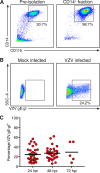


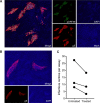
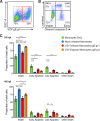

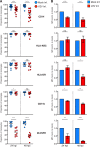
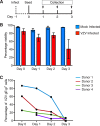

Similar articles
-
Varicella zoster virus productively infects human natural killer cells and manipulates phenotype.PLoS Pathog. 2018 Apr 30;14(4):e1006999. doi: 10.1371/journal.ppat.1006999. eCollection 2018 Apr. PLoS Pathog. 2018. PMID: 29709039 Free PMC article.
-
Lack of strong innate immune reactivity renders macrophages alone unable to control productive Varicella-Zoster Virus infection in an isogenic human iPSC-derived neuronal co-culture model.Front Immunol. 2023 May 23;14:1177245. doi: 10.3389/fimmu.2023.1177245. eCollection 2023. Front Immunol. 2023. PMID: 37287975 Free PMC article.
-
Human Embryonic Stem Cell-Derived Neurons Are Highly Permissive for Varicella-Zoster Virus Lytic Infection.J Virol. 2017 Dec 14;92(1):e01108-17. doi: 10.1128/JVI.01108-17. Print 2018 Jan 1. J Virol. 2017. PMID: 29046461 Free PMC article.
-
Immunobiology of Varicella-Zoster Virus Infection.J Infect Dis. 2018 Sep 22;218(suppl_2):S68-S74. doi: 10.1093/infdis/jiy403. J Infect Dis. 2018. PMID: 30247598 Free PMC article. Review.
-
Varicella virus-mononuclear cell interaction.Adv Virus Res. 2003;62:1-17. doi: 10.1016/s0065-3527(03)62001-4. Adv Virus Res. 2003. PMID: 14719363 Review.
Cited by
-
Varicella zoster virus encodes a viral decoy RHIM to inhibit cell death.PLoS Pathog. 2020 Jul 10;16(7):e1008473. doi: 10.1371/journal.ppat.1008473. eCollection 2020 Jul. PLoS Pathog. 2020. PMID: 32649716 Free PMC article.
-
Varicella Zoster Virus Downregulates Expression of the Nonclassical Antigen Presentation Molecule CD1d.J Infect Dis. 2024 Aug 16;230(2):e416-e426. doi: 10.1093/infdis/jiad512. J Infect Dis. 2024. PMID: 37972257 Free PMC article.
-
Herpes simplex virus type 1 impairs mucosal-associated invariant T cells.mBio. 2025 May 14;16(5):e0388724. doi: 10.1128/mbio.03887-24. Epub 2025 Mar 26. mBio. 2025. PMID: 40135871 Free PMC article.
-
The frequency of interleukin-1β-producing monocytes is significantly associated with varicella-zoster responses of nursing home residents.Clin Exp Immunol. 2021 Jul;205(1):63-74. doi: 10.1111/cei.13593. Epub 2021 Apr 4. Clin Exp Immunol. 2021. PMID: 33714219 Free PMC article.
-
Understanding the Mode of Action of Several Active Ingredients from the Micro-Immunotherapy Medicine 2LZONA®.J Inflamm Res. 2025 Mar 21;18:4267-4290. doi: 10.2147/JIR.S498930. eCollection 2025. J Inflamm Res. 2025. PMID: 40134411 Free PMC article.
References
-
- Arvin A. 2001. Varicella-zoster virus In Knipe DM, Howley PM, Griffin DE, Lamb RA, Martin MA, Roizman B, Straus SE (ed), Fields virology, 4th ed Lippincott Williams & Wilkins, Philadelphia, PA.
Publication types
MeSH terms
Substances
LinkOut - more resources
Full Text Sources
Research Materials

